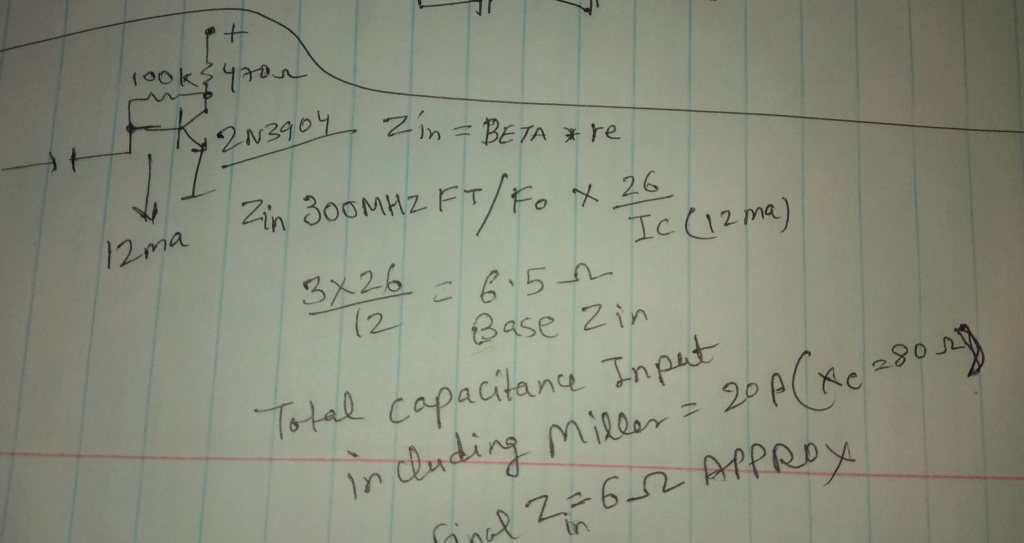Transistor input Z and BPF termination
2 posters
Page 1 of 1
 Re: Transistor input Z and BPF termination
Re: Transistor input Z and BPF termination
Hi Ivan,
Yes, you're right. I'm trying to use 2n3904 in small signal buffer/drivers and PN2222A in final so that the circuit can easily be replicated. RF transistors like 2n3866 are getting rare. But I've to use several stages as the gain is quite low but the circuit can be copied easily and cheaply. I was also able to get 700mW at 96MHz from two parallel PN2222As.
I've removed the final tuned circuit as it was oscillating on some other frequency. Output is 4mW only after 3 stages of amplification including the common base stage. You can tell if the filter is matched or not by listening to the audio quality.
Will this circuit work just as fine with the 7th harmonic, or 9th?
Yes, you're right. I'm trying to use 2n3904 in small signal buffer/drivers and PN2222A in final so that the circuit can easily be replicated. RF transistors like 2n3866 are getting rare. But I've to use several stages as the gain is quite low but the circuit can be copied easily and cheaply. I was also able to get 700mW at 96MHz from two parallel PN2222As.
I've removed the final tuned circuit as it was oscillating on some other frequency. Output is 4mW only after 3 stages of amplification including the common base stage. You can tell if the filter is matched or not by listening to the audio quality.
Will this circuit work just as fine with the 7th harmonic, or 9th?
dare4444- Posts : 427
Join date : 2013-03-19
 Re: Transistor input Z and BPF termination
Re: Transistor input Z and BPF termination
Hi,
my first answer was bound to your first schematic. That amplifiier is common emitter. Adding the first stage using common base improves the circuit behaviour and filter matching considerably. Using transistors with fT>1GHz still seems more promising to me - more gain, less tweaking.
BR from Ivan
my first answer was bound to your first schematic. That amplifiier is common emitter. Adding the first stage using common base improves the circuit behaviour and filter matching considerably. Using transistors with fT>1GHz still seems more promising to me - more gain, less tweaking.
BR from Ivan
Ivan- Posts : 796
Join date : 2012-11-25
Age : 64
Location : Praha, Czechia
 Re: Transistor input Z and BPF termination
Re: Transistor input Z and BPF termination
Del
Last edited by dare4444 on Sun May 22, 2022 4:39 am; edited 1 time in total
dare4444- Posts : 427
Join date : 2013-03-19
 Re: Transistor input Z and BPF termination
Re: Transistor input Z and BPF termination
Del
Last edited by dare4444 on Sun May 22, 2022 4:40 am; edited 1 time in total
dare4444- Posts : 427
Join date : 2013-03-19
 Re: Transistor input Z and BPF termination
Re: Transistor input Z and BPF termination
Hi dare,
the theory around BETA looks nice. But
- I expect that using a transistor at 1/3 ot its transit frequency will cause great problems;
- you neglected the phase shift on the input capacitance. Filters require a pure resistive load on both ends.
BR from Ivan
the theory around BETA looks nice. But
- I expect that using a transistor at 1/3 ot its transit frequency will cause great problems;
- you neglected the phase shift on the input capacitance. Filters require a pure resistive load on both ends.
BR from Ivan
Ivan- Posts : 796
Join date : 2012-11-25
Age : 64
Location : Praha, Czechia
 Similar topics
Similar topics» Antenna Input Impedance
» 250mW 40 Meter AM Transmitter
» 40mW FM Transmitter missing audio input
» Mixer local oscillator input levels
» ZTX327 transistor
» 250mW 40 Meter AM Transmitter
» 40mW FM Transmitter missing audio input
» Mixer local oscillator input levels
» ZTX327 transistor
Page 1 of 1
Permissions in this forum:
You can reply to topics in this forum



